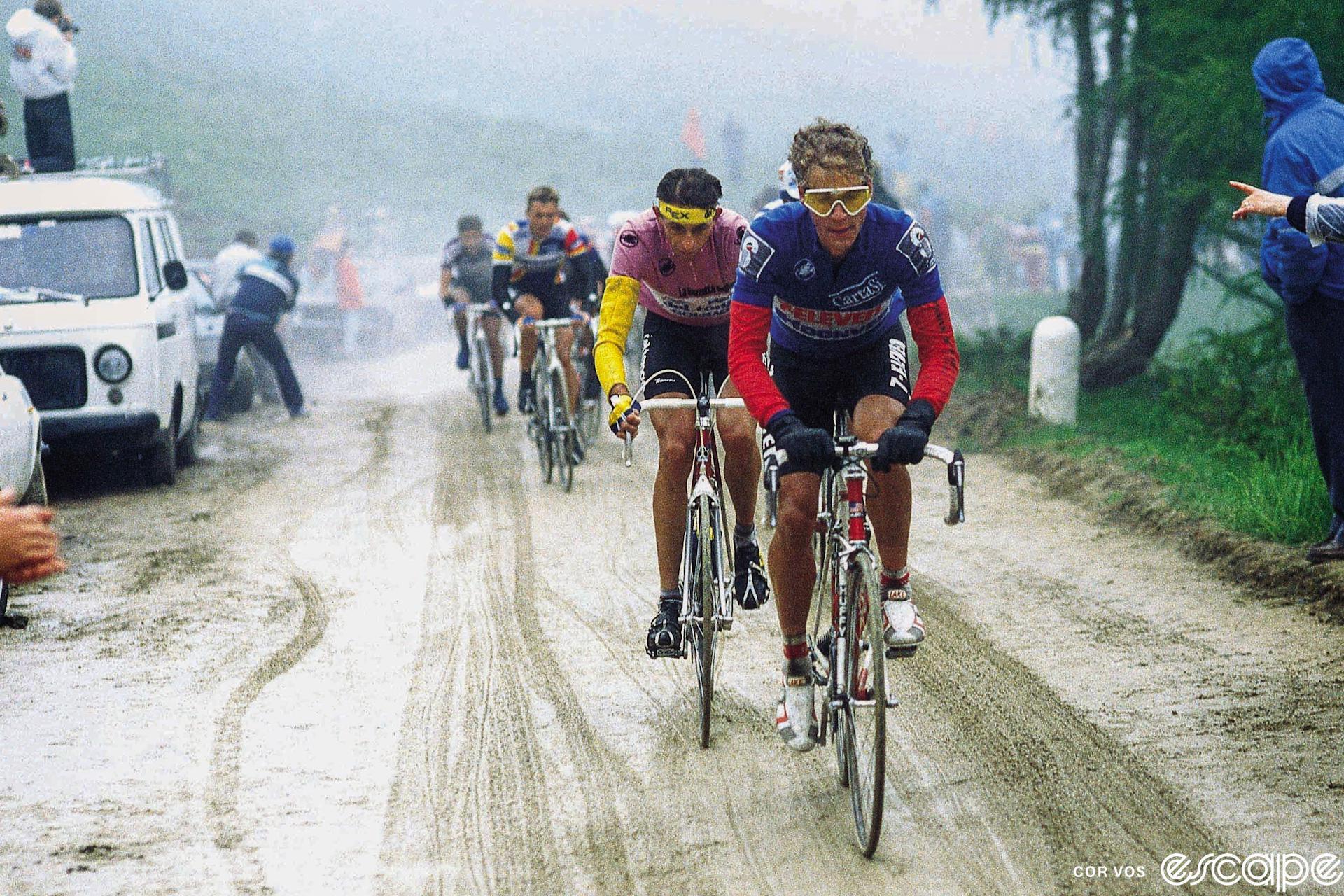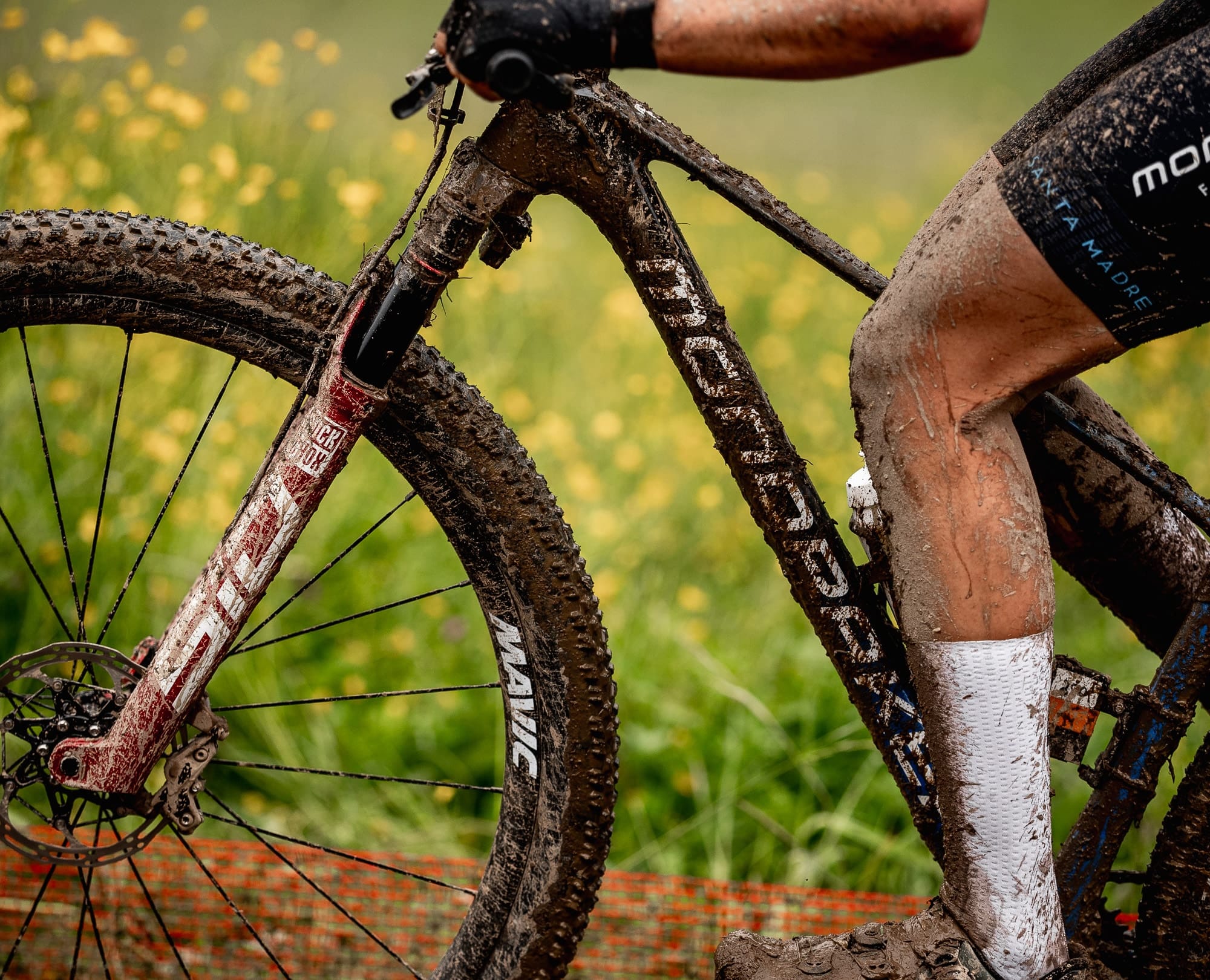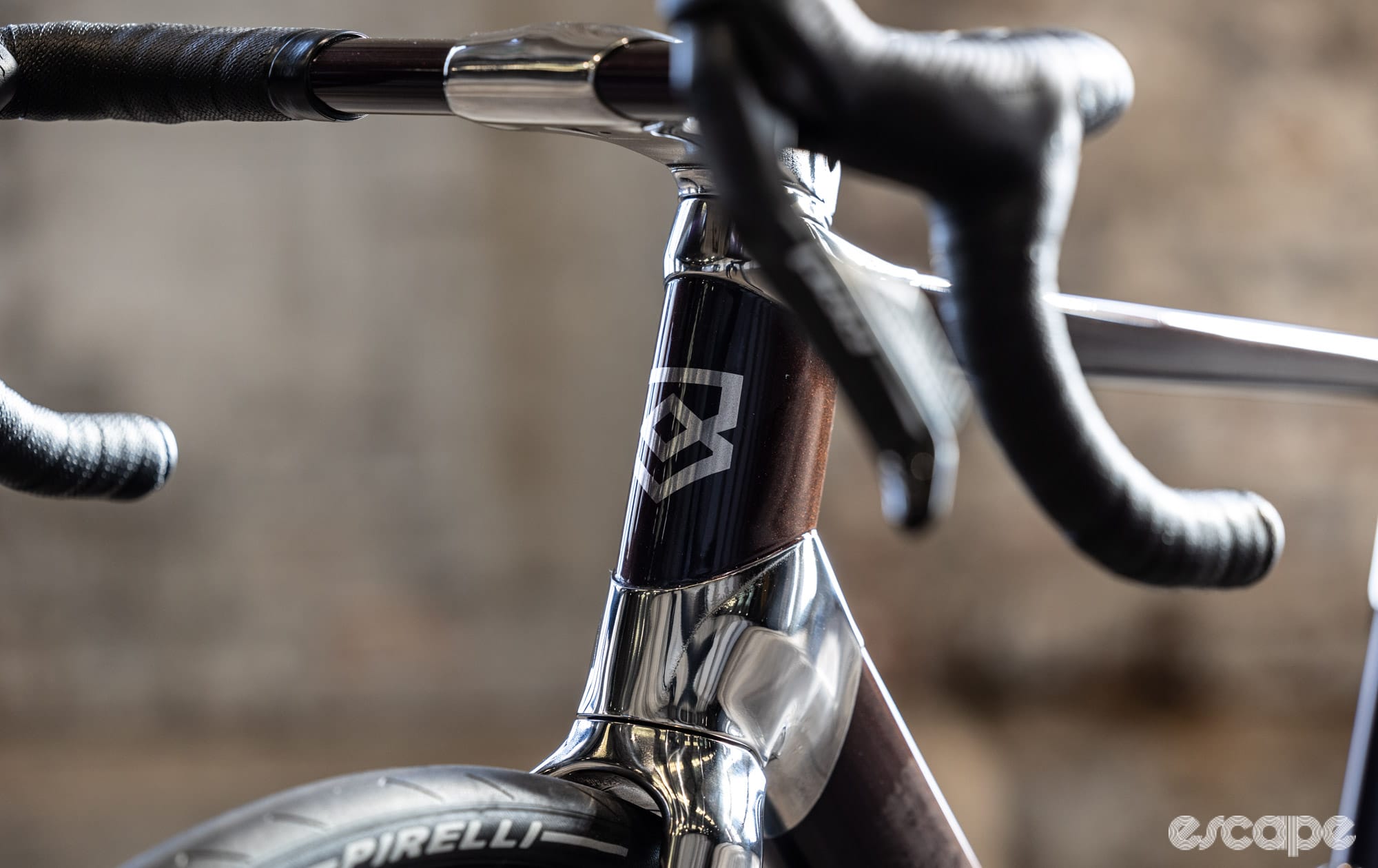Sunday, June 5, 1988, remains the hardest day on the bike for Andy Hampsten, a day when he and the peloton had to endure freezing snow, rain and mud on the Passo di Gavia before the finish of stage 14 of the Giro d’Italia in Bormio.
Hampsten placed second to Dutchman Erik Breukink on the now-fabled stage to take the overall lead which he would defend for a week to become the first American winner. But 35 years on, Hampsten still places the day on top of his hurt locker for pain and suffering as much for the joy it brought.
“I pushed myself psychologically to a place that I don't think I can go back to.” Hampsten, 61, recalls to Escape Collective from Castagneto Carducci in Tuscany, Italy where he and his wife Elaine – who have two children (daughter Emma, 27 and son Oscar, 11) – operate Cinghiale Cycling Tours.
“I remember as a cyclist in other races thinking, ‘I'm getting dropped. I need to go as hard as I can … push myself psychologically, go as hard as I did in the Gavia.’ But it was impossible. Physically, I could do one thing, but then, on the Gavia to make it down was the hardest thing I've ever done.”
Life is much different for Hampsten today. No longer does he have to push himself to such limits when he rides. He can cycle for pure enjoyment. At age 61, he is grateful that the bike is still the focal point of his life, in cyclo-tourism and manufacturing as the co-owner with his brother Steve of Seattle-based bike brand Hampsten Bicycles. He splits between the United States where he lives in Boulder and enjoys gravel cycling and skiing, and Italy where he and Elaine run Cinghiale and share their knowledge of local cycling, food, wine and all things great about Italy on tours held from spring to autumn.
But Hampsten still recognises the impact of that epic day on the Gavia: not only on his pro racing career, but life as it is now.
'Nobody respects how hard this climb is'
Hampsten's performance on stage 14, and in the Giro overall, did not come out of the blue. A gifted climber, Hampsten was already an established top pro, including placing fourth overall in the 1986 Tour de France, winning the white jersey as best young rider and helping Greg LeMond become the first American winner. He also won the 1986 and 1987 Tours de Suisse and had a Giro stage win in 1985.
He'd even already won a stage of that 1988 Giro. But stage 14, over the Gavia, is the one that put him in the pink jersey he would hold to the finish, and was the defining moment not only of the race, but Hampsten's career. He entered the day in fifth place at 1:18 down to race leader Franco Chioccioli and knew he was in good form after winning stage 12. He also had the belief of his 7-Eleven team and a masterstroke of pre-stage planning and foresight by former Italian professional Gianni Motta, who befriended him during his amateur days in Italy.
Motta fancied Hampsten in the Giro. Hampsten recalls him saying, “You're going to win the Giro. You're going to do it on the Gavia. No one's paying attention to how hard this climb is. I've raced with all the directors. They say, [for] the young riders these days with these super light modern bikes, a climb is a climb. Nobody respects how hard this climb is.'"
Motta was correct. The stage began in snow, but the peloton still largely underestimated what awaited on the way to the Gavia's 2,618-metre summit, with an average gradient of 8.5 per cent for the last 14 km, most of which was unpaved. They also underestimated what they'd face on the way down. The 7-Eleven team managed by Jim Ochowicz with sports director Mike Neel and Hampsten and Mexican Raul Alcala both racing as co-leaders was a noted exception.
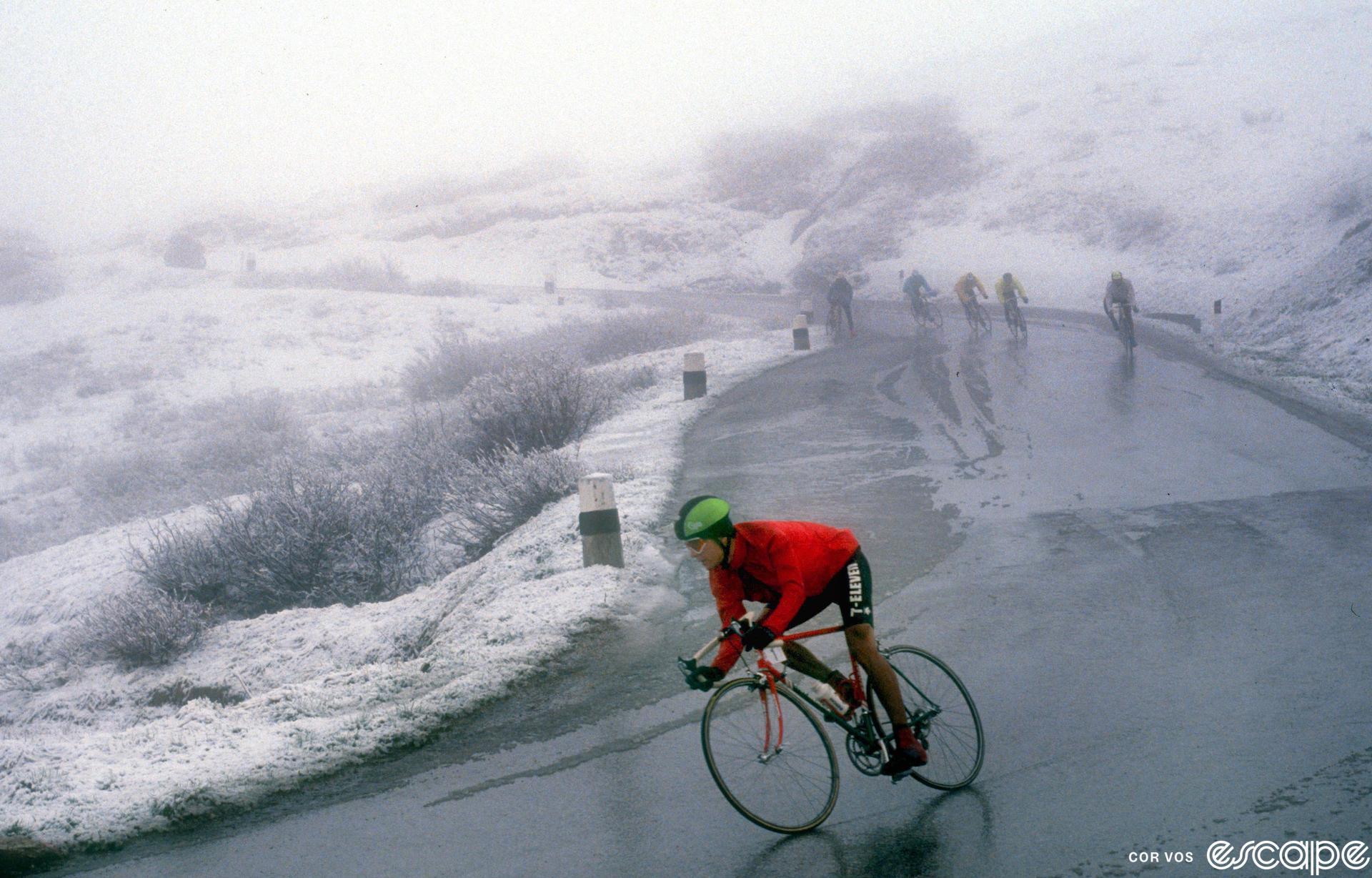
Before the start, the team’s staff was dispatched to buy as much extreme weather clothes that they could. At breakfast, riders were told to prepare an extra bag of kit to change into for the bone-chilling Gavia descent. “We knew it would be terrible,” says Hampsten. “We knew the storm was coming, the descent would be worse than the climb, that conditions were predicted to deteriorate. We knew it would be awful.
“We put lanolin all over our bodies. We each prepared a bag that would be [waiting] one kilometre from the top and given to us all with the warm clothes. We had hot tea with sugar. We didn't know who could be serviced by the two team cars [behind].”
Before reaching the Gavia, Hampsten, riding a nine-speed Huffy-branded bike (custom built by John Slawta of Land Shark), was already drenched and had stripped off “loads of soaking thermal gear” in readiness for the crucial climb that was to come.
On the Gavia’s early slopes, 7-Eleven rode as planned, near the front to a set mark where the gradient steepens. It was there where Hampsten says he planned to execute the first of three moves: “I knew 10 or 12 km from the top the road would narrow and turn to dirt, that it would be 14% (gradient). I thought, ‘I'm going to do three attacks to see what's what.'
“On the first [move], I could see everyone I was worried about was chasing. It was steep … everyone was on their own. I could [ride] 95% tempo to save energy and enough glycogen in my body to keep my brain working for the descent. The idea was not to worry about seconds on the climb. A mistake – or not – would be minutes on the descent.”
As Hampsten climbed, a team car remained nearby. “I started looking at Chioccioli and my competitors," he recalls, "Everyone looked terrible.” Then Mike Neel’s words at the team meeting came to mind: “This is the day we've been waiting for. This is the day to attack. If you can do it, do it. No extra pressure, but the bad weather raises the stakes.”
From that moment, Hampsten continues, “It all clicked. I remember saying to [teammate] Bob Roll, ‘Prepare yourself. You're going to go places in your head you've never been to before.’ Was this going to be hell? It was, yeah.”
And “hell’ it was for all, from the front of the race where Dutchman Johan van der Velde was riding alone in a brazen solo attack on the higher slopes of the Gavia (yet without even a gilet to protect him from the conditions), to the very end of a splintered peloton that was one long suffering line; at least a dozen riders DNF'd.
Van der Velde – third overall in the 1982 Tour and fifth in the 1984 Giro – led over the Gavia. But he had to take refuge in a hut on the descent to warm up and ultimately finished 42 minutes down on the day. Behind Van der Velde at the summit came Hampsten and Erik Breukink.
A little earlier, the Dutchman caught Hampsten, who lost time fumbling in neoprene diving gloves to put on a rain jacket. Behind them came a strung-out peloton of whom most had to stop to seek aid from a tifosi offering the warmth of blankets and their cars, food and hot tea, coffee, even grappa.
The 25 km descent to Bormio proved to be as crucial as predicted. Hampsten was dropped by Breukink with seven kilometres to go; but instead of chasing Breukink, he focused on holding his time on those behind, the closest being the Swiss Urs Zimmerman. It was the right call; Hampsten finished just seven seconds behind Breukink, but more than four minutes ahead of the closest chaser. Those margins put Hampsten with a comfortable lead over all but Breukink, 15 seconds behind.
The stage also entered cycling folklore for how it panned out or, rather, that it ran at all. “The fact that everyone went ahead with that stage was, for the sport and fans, [a reminder of] how cycling was in the '50s, '30s or the turn of the [20th] century,’” Hampsten reflects.
“That the race continued through really bad weather may have added a lot of meaning for a lot of fans. Part of the interest in cycling is, ‘How do these people do it for seven hours through the rain and over cobbles?’ Lots of fans can really relate to that, thinking, ‘That's like me working in the fields for 10 hours.’ People suffer in endurance sport.”
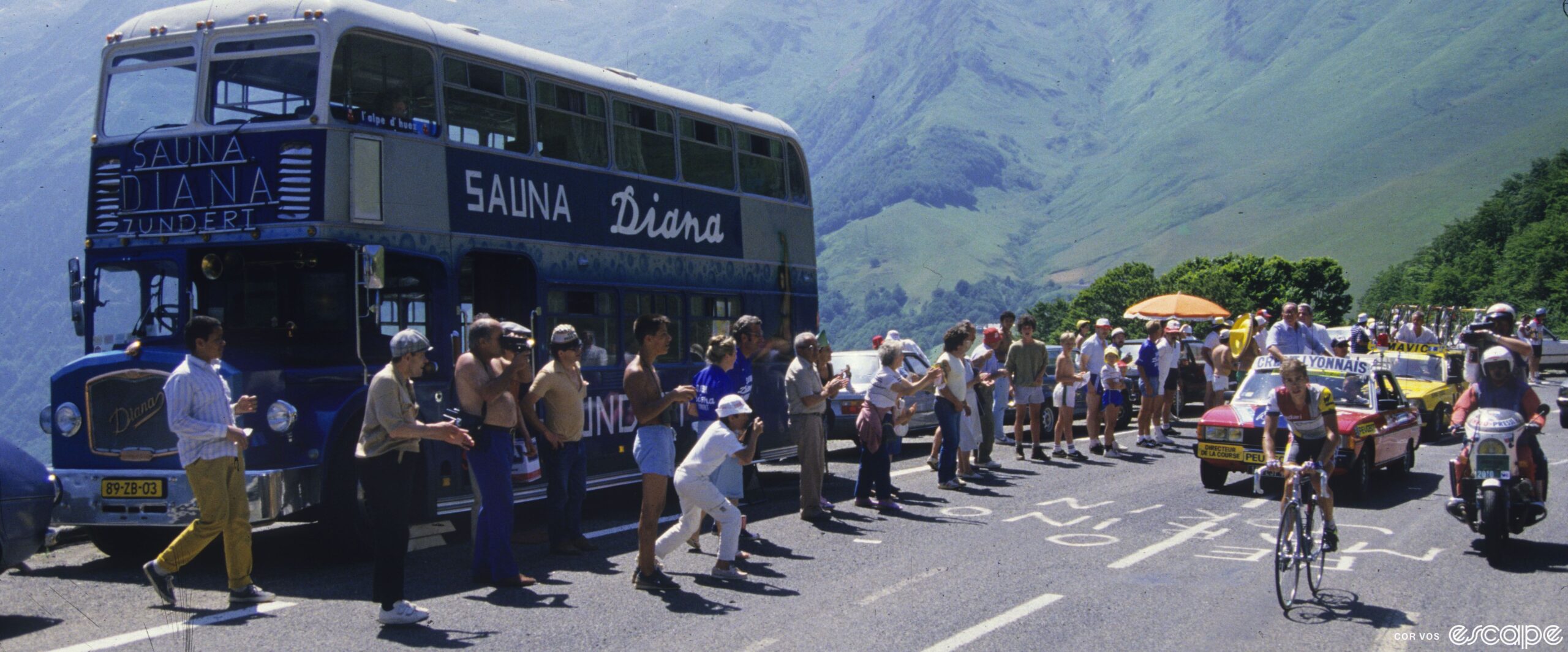
Hampsten would also win the stage 18 time trial and hold or steadily grow his lead all the way through the finish in Vittorio Veneto, becoming just the second American ever to win a Grand Tour.
The 1988 Giro is so indelible in fans' minds that it overshadows even some of Hampsten's other amazing stories from his career, not least of which was a front-row seat to the Bernard Hinault-LeMond rivalry that animated the 1986 Tour, the first Grand Tour won by an American rider.
'The only teammate I ever had to chase'
Hampsten’s lone professional season with the talent-rich French La Vie Claire team in 1986 – led by five-time Tour winner Bernard Hinault and rising American star LeMond – was laden with drama and success.
If Hampsten had to learn the ropes of professional cycling, he was about to get a PhD when he was selected for La Vie Claire’s Tour team. La Vie Claire was riddled with tension stemming from the 1985 Tour where Hinault and LeMond's rivalry had sparked. Hinault won the race, but LeMond felt he could have. LeMond only held back under the promise of Hinault and the team – owned by the French businessman, entertainer, and politician Bernard Tapie, that they would ride for LeMond in 1986.
But suspicion that Hinault would not abide by the agreement simmered, and as expected it boiled over in the 1986 Tour. Hinault, says Hampsten, was “the only teammate I ever had to chase." Hampsten lauds Hinault for his mentorship at La Vie Claire, especially during his 1986 Tour de Suisse win that secured his Tour team selection. But says Hampsten: “[Hinault] put himself in a corner. He told me and all the others that we were going to help Greg, hand [the Tour] to him on a silver platter. Then the silver platter went away and he had to fight for it, which I understand, but it was no fun being on the team.”
Hampsten cites stage 13 from Pau to Superbagnères, the second day in the Pyrénees. Hinault, who took the overall race lead the day before, had attacked but was caught and dropped. LeMond, second overall, won the stage and took back 4 minutes 45 seconds of Hinault’s overnight lead of 5:25. Hinault still led, but was separated from LeMond by only 40 seconds. Hampsten had also taken the white jersey that was then for the best placed Tour debutant.


The La Vie Claire dinner table was a tinderbox of emotion that night. At one end, Hampsten recalls, sat the French riders – their iconic leader Hinault, the rising star Jean-François Bernard – who had been promised Tapie’s Porsche 911 if he won the white jersey, Charly Bérard, Philippe Leleu, and Alain Vigneron. At the other end were Hampsten, Canadian Steve Bauer, and a Tour-hungry LeMond. In the neutral middle, fittingly, were the Swiss riders, Nikki Rütimann and Guido Winterberg.
“It was full stress … full, full, full stress,” recalls Hampsten. “Tapie flies in, he's going to settle it all … have meetings before dinner. LeMond comes in from his meeting and sits next to Steve and I. We said, ‘How did it go?' He said, ‘He's not going to do anything now … they're not going to control it,’ and doesn't tell everyone. Then Hinault comes in and sits on the other end by the French guys. No one dares ask them how it went because we already know. You can hear a pin drop.
“Then Greg … He's tearing the centre out of the baguettes and throwing them at people … first at the Swiss, then at the French. Then Tapie walks in. He’s all show and has a beaming smile, but looking at us trying to figure out if we know that he didn't do anything. He doesn't really know what to say.
“Then Greg shouts, ‘Hey, Bernard, now Andy has the white jersey, are you going to give him the Porsche?’ There was tension at the table, but with Greg it didn't last very long.”
LeMond rode on to become the first American to win the Tour in 1986. But fate also shone favourably on Hampsten. He finished fourth overall and defended the white jersey, but never got the Porsche.
From le Tour to Touring in Tuscany
Winning the Tour became Hampsten’s dream when he joined 7-Eleven in 1987. “That [1986] Tour showed me I could do very well,” he says. “It became the focus every year.” But the dream was never realised. His best finish was another fourth in 1992 when he won stage 14 to l'Alpe d'Huez, riding for Motorola.

While a native of Columbus, Ohio, Hampsten’s resilience stems from his upbringing from age 8 to 13 in the isolated, cold and windy climes of Grand Forks, North Dakota. In 1992 The Andy Hampsten Bikeway System was opened there in his honour. “Being from a cycling-remote place, I had to struggle to get on the national team for the international races and show enough talent to become a professional,” he says. “In Europe, it was, ‘I'm on a one-way ticket.' I can't say, ‘I’ll try again next week if it's not working.’ I never gave myself that luxury. I tried to make the most of every race.”
But as with everything, there is an end. For Hampsten, as a professional cyclist that end came in 1996 at the age of 34. After one season on Banesto, he raced his 12th and final year in 1996, for U.S. Postal Service. “I was never going to win the Tour. That [dream] got me through training year in, year out,” says Hampsten.
Part of his choice came down to the growing impact of EPO use in the sport. It sounds ironic given what the team would become, but for Hampsten USPS was a means to help guide other riders to ethical choices. “Part of the reason I joined a small team, spending the end of my career with US Postal, was that most riders were 10 years younger than I was. Everyone had to make their own choice, but I was in a position where I could tell them, ‘It's great being a racer, but it's a brief part of your life. You don't want to be beaten by people cheating, but you have a long way to go after. Don't live the rest of your life regretting decisions.’"
Hampsten retired with no regrets. He had an eye on the future, encouraged by his mother Elizabeth who, like his father Richard, was a professor of English at the University of North Dakota. “Before I stopped my mother came to visit me in Italy and said, ‘What will you do next?’” Hampsten says. “I tried to laugh it off, but she made me come up with a plan.”

His plan was to start Cinghiale, named after the wild boar that roam freely in Italy, happily foraging for fruits of the land. The business, which he and Elaine started in 1998, is based in Castagneto Carducci in western Tuscany, and allows him to share his love of cycling on many of the quiet and picturesque roads that head to the Mediterranean or into the hills and mountains he had trained and raced on in Italy, as well as his and Elaine’s deep passion for Italian food, wine, and culture with clients.
“It's really fun sharing the places and people that I know with guests, mostly from America, but also Australians, English, Canadians – mostly English-speaking guests,” Hampsten says.
“The idea is not to share so much of the sport of cycling, but to move around Italy in a very welcoming mode of travel.
“When we roll into a village, in most places the locals are curious. There's a lot of great exchanges. Often, we find ourselves in the most obscure village, excusing ourselves to the little old lady on the park bench because 20 of us are eating and drinking water, yakking in English quite loudly.”
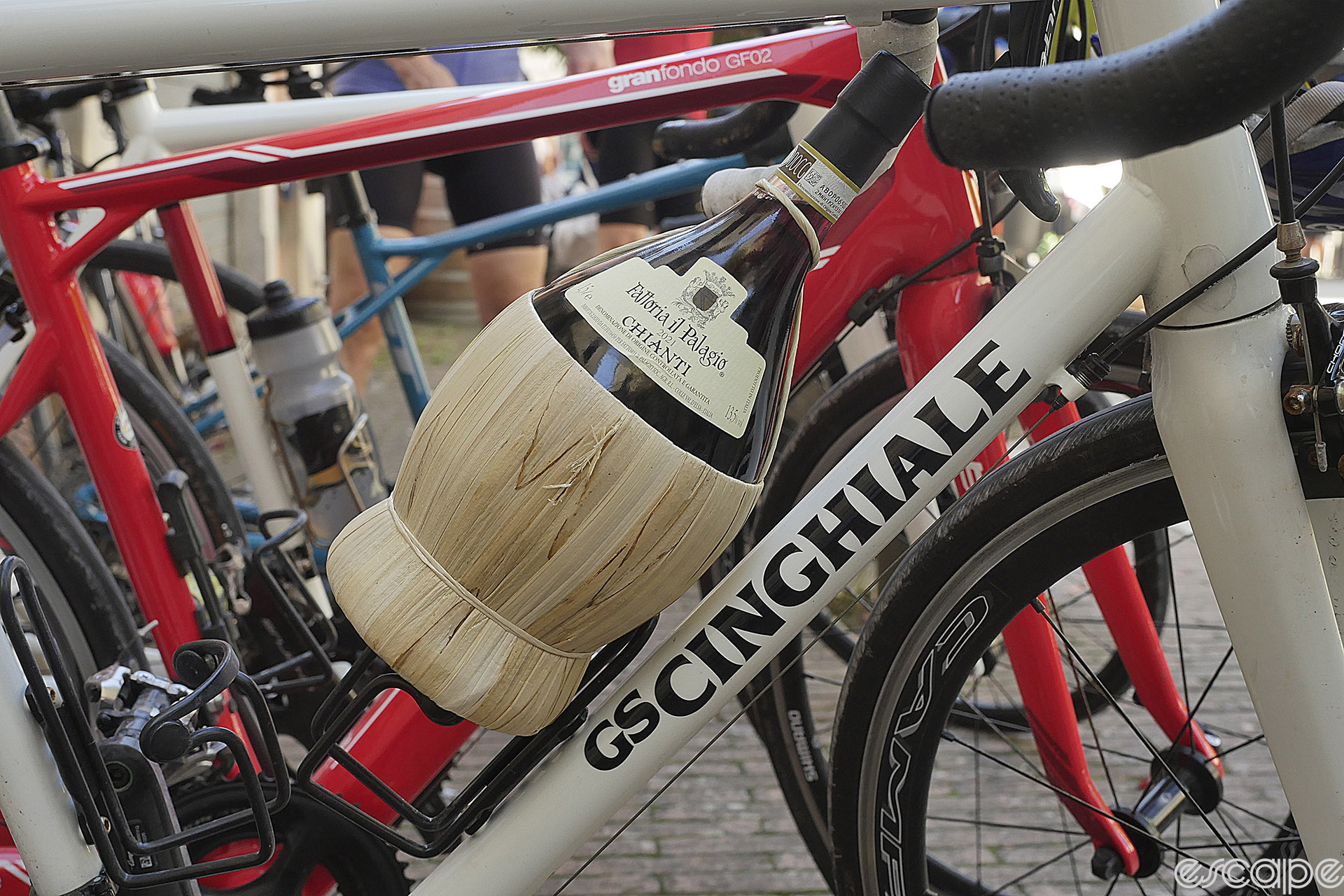
Nevertheless, Hampsten still enjoys watching bike races, especially the Spring Classics and with his son, Oscar. “He's good with tactics,” Hampsten says of Oscar. “He likes the helicopter shots to see which guys hold back, or not.”
The duo also love soccer. Oscar, jokes Hampsten, “is going to win the World Cup and then the Tour. I’ll have to push him with the Tour; but the World Cup, he's got in the bag. He loves the underdog. So, [playing for] the U.S. works out well.”
As it did for Andy Hampsten when, as a relative youngster on stage 14 of the 1988 Giro, he raced through biting rain, snow and mud on the Passo di Gavia to set up an historic victory, a win that shaped his life for decades to come, and in some ways still does.
Did we do a good job with this story?
